Fetal surgery—including surgical interventions to repair birth defects in the womb—is progressing into medical practice in highly specialized centers. Advanced imaging and diagnostic tools, new instruments and medications, and greater depth of experience are driving this rapidly evolving frontier of medicine.
“Birth defects remain the leading cause of infant mortality in the United States, but we have been privileged to help advance the treatment of these defects in ways that were only dreamed of a generation ago,” said fetal and pediatric general surgeon N. Scott Adzick, MD, medical director of the Center for Fetal Diagnosis and Treatment (CFDT) at The Children’s Hospital of Philadelphia (CHOP), where he is surgeon-in-chief.
Internationally prominent as a pioneer in fetal surgery, Adzick is the guest editor of the Feb. 2013 issue of the journal Seminars in Pediatric Surgery, an issue entirely devoted to advances in fetal surgery. This is the third time in 20 years that Adzick has taken on this role, updating the state of this field since his previous contributions to the same journal in 1993 and 2003.
Focus on diagnostic and treatment innovations, basic science insights, and therapy improvements
Adzick and the article authors, all current or former members of the CFDT at CHOP, describe innovations in imaging modalities, surgical techniques and instrumentation, insights from basic science, and improvements to therapy grounded in experience and practice, including a landmark clinical trial of fetal surgery for spina bifida. “The presentations reflect the philosophy of one center, gleaned from two decades of clinical and experimental work,” Adzick writes in his preface to the special issue.
The CFDT is a premier program, one of a handful worldwide to offer a full range of fetal procedures. Since the center opened in 1995, more than 13,000 parents have used its services, from all 50 U.S. states and from over 50 other countries.











